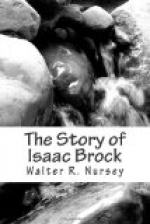“BATTLE OF QUEENSTON.
AFTER A SKETCH BY MAJOR
DENNIS,
13TH OCT., 1813,
Which ended in a complete victory on the part of the British, having captured 927 men, killed or wounded about 500, taken 1,400 stand of arms, a six-pounder, and a stand of colors.”
(See, also, Explanatory Note to No. 15.)
NO. 19. FACING PAGE 163.
Plan of Battle of Queenston.
Reproduced from an historical pamphlet loaned by Mrs. Currie, of Niagara, showing the plan of battleground, disposition of troops, and topography of adjacent country.
NO. 20. FACING PAGE 170.
Taking of Niagara, May 27th, 1813.
From a sketch which appeared in the Philadelphia Portfolio, 1817. Interesting from the fact that it is the only picture known which shows the churches of St. Mark’s and St. Andrew’s, Niagara (Newark), Canadian side, and the lighthouse which, built in 1803, stood on the spot where Fort Mississauga now stands.
NO. 21. FACING PAGE 172.
Cenotaph, Queenston Heights.
Erected near the spot where Brock fell. It bears the following inscription:
“NEAR
THIS SPOT
MAJOR-GENERAL
SIR ISAAC BROCK, K.C.B.,
PROVISIONAL LIEUTENANT-GOVERNOR OF
UPPER
CANADA,
FELL ON 13TH OCTOBER, 1812,
WHILE ADVANCING TO REPEL THE
INVADING
ENEMY.”
NO. 22. FACING PAGE 174.
Brock’s Monument.
On October 13th, 1824, the remains of Brock and his gallant aide, Macdonell, were removed from the bastion at Fort George and placed in a vault beneath the monument which had been erected on Queenston Heights by the Legislature to commemorate our hero’s death. On Good Friday, April 17th, 1840, this monument was shattered by an explosion of gunpowder placed within the basement by a rebel of 1837 named Lett. In 1853 the cornerstone of a new monument, as shown at page 174, the cost of which was borne by the people of Canada, was erected on the same spot, and on October 13th, forty-one years after the British victory at Queenston, and the anniversary of Brock’s splendid death, the remains of the two heroes were re-interred and deposited in two massive stone sarcophagi in the vault of the new monument. On the two oval silver plates on Brock’s coffin was inscribed the following epitaph:
“HERE LIE THE EARTHLY REMAINS
OF A BRAVE
AND VIRTUOUS HERO,
MAJOR-GENERAL SIR ISAAC BROCK,
COMMANDER OF THE BRITISH FORCES,
AND PRESIDENT ADMINISTERING
THE GOVERNMENT OF UPPER CANADA,
WHO FELL WHEN GLORIOUSLY ENGAGING THE ENEMIES
OF HIS COUNTRY,
AT THE HEAD OF THE FLANK COMPANIES
OF THE 49TH REGIMENT,
IN THE TOWN OF QUEENSTON,
ON THE MORNING OF THE 13TH OCTOBER, 1812,
AGED 42 YEARS.




